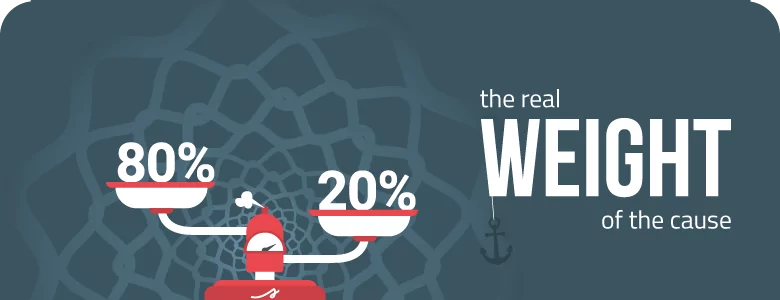
All managers have, at some point, gone through periods where responsibilities and demands are overwhelming. With the mission of achieving satisfactory results, managing your team, organizing demands and also making employees more productive. For them, time is not on their side, the market has created strategies that enable the functioning of these demands. One such tool is Pareto Analysis.
First used in 1941, this theory brought new insight into the causal relationship within companies. That is, each action generates a reaction and understanding its causes can determine the success or failure of your business.
In the following post, we’ll explain to you how this method works and how to implement it in your business. Are you interested? Well, check it out!
Also known as the 80/20 principle, the ABC Curve or the Pareto Diagram, Pareto Analysis is a table, usually in the form of a column chart, that groups and orders the frequency of particular occurrences. It’s all based on a very simple idea: 80% of the consequences come from 20% of the causes.
The name is a tribute to the Italian economist Vilfredo Pareto. He identified that a concentration of 80% of the economy remained in the possession of only 20% of the population. And that was what generated the main economic problems of the country.
We often worry about unimportant problems. This method, in turn, aims to demonstrate that people can use their time and energy on really serious issues.
The same goes for the work being done. Instead of spending hours on repetitive activities, you can focus on specific, more strategic actions that will generate the most results.
When it is difficult to build customer loyalty in a company, it is common to resort to new marketing strategies or product updates. However, the resolution can be much simpler! An unprepared customer service industry, for example.
The greatest use of this method is that it allows for an easy identification of what is really harmful at the professional, personal and organizational levels. List the points, in order of importance, and concentrate efforts on the most effective resolution.
The Pareto Principle (80 /20) is widely used in companies when it comes to quality control over products and services. But it is very important, too, for better decision making.
When a manager has a complete picture of their problems and prioritizes their resolution, it is much easier to avoid potential crises and create more assertive strategies. When you know which attitudes lead to a particular goal, action focuses only on those attitudes and eliminates actions that are irrelevant.
If a company’s main goal is, for example, to improve the relationship with its target audience in branding, not finding out who they are and what they are looking for can impact the number of sales.
Using this methodology, in this case, will consist of segmenting the clientele. That is, list who your customers are in the order they most consume or contact your business, and then create actions that target them.
In practice, this minimizes efforts, helps to improve brainstorming and team interaction, reduces the amount of resources invested unnecessarily and generates more profitable results.
The Pareto Diagram is very practical to use and can be done more easily with the help of software that has a set of spreadsheets, tables and charts.
First of all, it is important to remember that the percentages that name Pareto Analysis are only figurative. Not every company will have these numbers in practice. They are only meant to show the discrepancy between problems or work done vs. results obtained.
The step by step guide to creating it and putting it into practice consists of:
Using this strategy may seem like a waste of time at first glance. But with it, you can more clearly see the frequency of both negative and positive episodes. This way you can share them more easily with the entire team.
Having this notion is important for measuring the real impact of problems and causes. And from there, understand how they affect your business, then improve most results (the 80%). To ensure the efficiency of Pareto Analysis, collect data effectively, without relying on assumptions and make sure all of your employees participate in it!
So, do you now understand Pareto Analysis? Do you think this technique can make a difference in your company?
With STRATWs One, Siteware’s enterprise management software, you have access to the Improvement Opportunities module, which has a fully customizable Pareto Diagram for you to use!
Revolutionize the management of your company with STRATWs One
Your technology partner to connect you to what really matters.